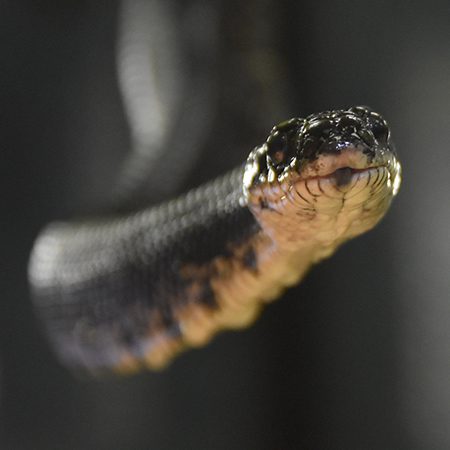Black Rat Snake
Pantherophis obsoletus
Black rat snakes are common throughout most of the Eastern United States, including Missouri. Because of this, there is not just one preferred habitat. They are found in rocky hills, forests, and even flat farmlands. They are bicolored; consistently all black except for their underside, which is white. Size wise, they are 4-6 ft long with a body diameter of around 1.5 inches and 3-4 lbs. Their head is wider than the rest of their body. These snakes are able to climb trees and swim. These skills are useful in catching prey. Generally, they spend much of their time in trees or rock crevices. Like all of our other snakes, rat snakes are constrictors. This means that they wrap their bodies around their prey and squeeze the life out of it.
Rat snakes are known to emit an odor to deter predators and are known to be pretty shy snakes. Though they are shy and may freeze when in contact with a human, they are helpful to have around because they can control pest populations. Because they are cold-blooded and live in cold temperatures, rat snakes will brumate. This is like partial hibernation where they are mostly asleep but can do small activities like drinking water.
Say Hello To Cub Creek's Snake: Obsidian
Obsidian is unlike our other snakes here at camp because he is native to campgrounds. Our owner found him in the summer of 2016 and now we can use him for education of Missouri’s native species. He is not a pet snake, so we do not take him out except for a few educational purposes. His favorite activity is to hide in his log.

Black Rat Snakes are found throughout the United States ranging from the eastern coast of New England to the Midwest, and southern parts of the U.S.
HABITAT -Habitat varies from mountains to forests to grasslands.
DIET -Being carnivorous, they will eat small rodents, lizards, frogs, and eggs.
FUN FACT -They will vibrate their tail in leaf litter to simulate having a rattle.
SOCIAL BEHAVIOR -Are fairly docile in nature, if a little shy, and are solitary.
ACTIVITY -They can be both diurnal and nocturnal, depending on the season.
PREDATORS -Hawks and other larger snakes are known to eat them.
SIZE -Can be 4-6 ft and 1.5 in diameter and 3-4 lb.
RELATIVES -Are related to other rat snakes, such as the Western Black, Grey, Yellow, and Texas.
CONSERVATION -The are Least Concern under the IUCN Red List.
Cub Creek Animal Care Information
Housing - Our snakes are housed in our Reptile room, which also features many of our lizards. They live in large heat and UV light-controlled enclosures. Fresh water and plenty of places to hide and explore are provided for them.
Diet - Once a week, our snakes are fed frozen mice that are tailored to the snake’s size. Snakes have very slow metabolisms, so they do not need to be fed often to receive all of their necessary nutrients.
Enrichment - Reptiles do not need a lot of enrichment beyond their various hides. Our campers give them plenty of stimulation by handling them and even occasionally bringing them outside on warmer days in the summer.

